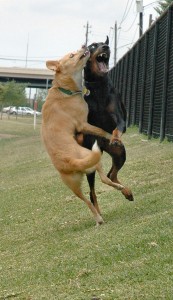Michael Baugh CPDT-KA, CDBC
Let’s start with the good news first. Most dogs are not intent on killing each other. That’s not to say they don’t have conflicts. They do; and those conflicts can sometimes be scary, noisy and even hurtful. Still, in most cases dogs don’t settle the score with fatal consequences.

In fact, dogs give each other plenty of signals when they are upset about something. They growl, snarl, lung and even snap wildly at the air. You’ll hear some trainers refer to that as “ritualized aggression.” Think: argument or the occasional sign language you see in Houston traffic. It’s unpleasant and communicative, but not dangerous in and of itself. There are more subtle nuances as well, the slight change ear posture, facial expression, breathing rate, or pupil dilation. When it comes to their own kind, most dogs are expert communicators. The reason is simple and serious. Real fighting is costly in terms of both risk and expended energy, so dogs have to be very good at resolving things without physical conflict.
If we step back a bit we can see most inter-dog aggression is about stopping some perceived threat and making the other dog go away. Increased distance often resolves the argument. This is most obvious in dogs who guard food and objects from other dogs. It’s also evident in dogs who lack experience interacting with other dogs. Animals, including the human animal, tend to reject things they don’t understand. Dogs who aren’t familiar with their own kind keep their distance. They might run away and hide as adolescents and young adults. Later as more mature adults, they might put on an aggressive display or worse to make the other dog go away. Either way, the message is clear. “Stay away from me.”
The real trouble arises when the dogs can’t properly communicate, and when one or both of them can’t retreat. They’re trapped. This is especially true in the case of dogs who are specifically aggressive towards other dogs while on leash. It is, perhaps, the most common form of inter-dog aggression.
Jean Donaldson (1996) first identified the on-leash cycle of aggression. It begins with well-meaning people who take their new dog or puppy on a walk for the first time. The dog, naturally curious, pulls toward other dogs he sees out in the wide world. He may even bark. The owner, frightened or angered by the pulling, yanks back on the leash yelling “heel” or “no bark.” Trying to stop the problem, the person might invest in a choke or prong “training collar” for his dog. Then, even if the dog begins to pull less, the owner keeps tension on the leash every time another dog is near just in case. As the weeks and months roll by, the dog learns that whenever he’s on leash and other dogs are around things get a little scary and maybe painful. He’s unable to investigate his own kind, and his owner is freaking out (or at the very least anxious). Before long the pulling and barking turns into lunging and growling, plus more yanking on the leash and yelling. Now dogs on walks are no longer a curiosity but a trigger that something bad is going to happen. We don’t know for sure what the dog is thinking, but we can imagine it might be “Get out of here dog, you’re making my owner freak out and he’s choking me.” Imagine how much worse this becomes if the other dogs in the neighborhood are trapped in this same cycle.
Prevention is always easier than a cure. Would that we could turn back time and stop the cycle before it starts. We’d teach our young dogs and puppies how to meet other dogs while on a leash. We would hold the leash without pulling it taught; we’d keep the line slack while two friendly dogs sniffed and circled each other. On our best days, we’d chat up the neighbors and admire each other’s dogs. Some days our dogs would play in an enclosed area off-leash. Each day we and our dogs would become more social.
Fixing the problem takes more effort. However, there is help. Qualified dog trainers and veterinary behaviorists can outline a plan that includes protecting your dog from having more aggressive displays. The plan will also involve reward-based training, teaching appropriate behavior while helping him feel better about his own kind. The prognosis is usually better with younger dogs, but there is always hope.
Dogs, I’ve discovered, are amazingly adaptable. At their core, they are social animals. Even the hardest cases can and do show some improvement. I guess that too is the good news.
(originally published in Houston PetTalk Magazine August 2011)
